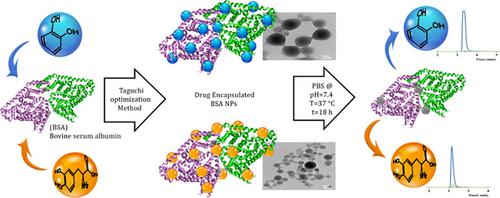当前位置:
X-MOL 学术
›
J. Chin. Chem. Soc.
›
论文详情
Our official English website, www.x-mol.net, welcomes your
feedback! (Note: you will need to create a separate account there.)
Encapsulation of L‐dopa and catechol in bovine serum albumin nanocarrier using desolvation method and their in vitro release studies
Journal of the Chinese Chemical Society ( IF 1.6 ) Pub Date : 2020-06-04 , DOI: 10.1002/jccs.202000018 Aysan Rafipour 1 , Abdollah Yari 1 , Khalil Farhadi 2 , Firouz Ghaderi Pakdel 3
Journal of the Chinese Chemical Society ( IF 1.6 ) Pub Date : 2020-06-04 , DOI: 10.1002/jccs.202000018 Aysan Rafipour 1 , Abdollah Yari 1 , Khalil Farhadi 2 , Firouz Ghaderi Pakdel 3
Affiliation

|
In the current study, the interaction between L‐dopa and bovine serum albumin (BSA) as well as catechol and BSA is investigated separately. In order to achieve the optimum values for encapsulated efficiency (EE), the content of crosslinker/BSA, organic/aqueous phase, drug/BSA, stirring rate, and pH were closely studied taking the advantage of Taguchi method. Particle characterization was carried out using transmission electron microscopy and dynamic light scattering techniques. The most appropriate catechol and L‐dopa nanoparticles in the size range of 100 nm and 65 nm, respectively, and at optimized conditions of drug/BSA = 0.1, pH = 7.4, crosslinker/BSA = 0.084, organic/aqueous phase = 4 and stirring rate 400 rpm were obtained. The most favorable EE (encapsulation efficiency) and LC (loading capacity) for L‐dopa and catechol was estimated to be 88.1% and 83.6%, respectively, and the calculated LC% was achieved 93.4% and 89.7% for L‐dopa and catechol, respectively. The chromatographic analyses results were also found to be in a good agreement with the obtained data for the calculated EE% and LC% values. in vitro release of loaded drugs from nanoparticles in phosphate‐buffered saline (pH = 7.4, incubated at 37 ± 0.5°C under stirring rate of 100 rpm) showed the release of 78% catechol and 89% L‐dopa during 480 min and 510 min, respectively.
中文翻译:

去溶剂化法在牛血清白蛋白纳米载体中包封左旋多巴和儿茶酚及其体外释放研究
在当前的研究中,左旋多巴与牛血清白蛋白(BSA)以及儿茶酚和BSA之间的相互作用被单独研究。为了获得最佳的包封效率(EE)值,利用田口法(Taguchi method)的优势,对交联剂/ BSA,有机/水相,药物/ BSA,搅拌速率和pH的含量进行了密切研究。使用透射电子显微镜和动态光散射技术进行颗粒表征。最合适的儿茶酚和左旋多巴纳米颗粒分别在100 nm和65 nm的大小范围内,并且在药物/ BSA = 0.1,pH = 7.4,交联剂/ BSA = 0.084,有机/水相= 4和获得400rpm的搅拌速率。左旋多巴和邻苯二酚的最有利EE(包封效率)和LC(负载量)估计分别为88.1%和83.6%,计算得出的左旋多巴和邻苯二酚的LC%分别达到93.4%和89.7% , 分别。色谱分析结果也与计算得出的EE%和LC%值与获得的数据相符。在磷酸盐缓冲液中(pH = 7.4,在37±0.5°C下以100 rpm的搅拌速度孵育)纳米颗粒中负载药物的体外释放表明在480分钟和510分钟内释放了78%的邻苯二酚和89%的左旋多巴分钟,分别。色谱分析结果也与计算得出的EE%和LC%值与获得的数据相符。在磷酸盐缓冲液中(pH = 7.4,在37±0.5°C下以100 rpm的搅拌速度孵育)纳米颗粒中负载药物的体外释放表明在480分钟和510分钟内释放了78%的儿茶酚和89%的左旋多巴分钟,分别。色谱分析结果也与计算得出的EE%和LC%值与获得的数据相符。在磷酸盐缓冲液中(pH = 7.4,在37±0.5°C下以100 rpm的搅拌速度孵育)纳米颗粒中负载药物的体外释放表明在480分钟和510分钟内释放了78%的儿茶酚和89%的左旋多巴分钟,分别。
更新日期:2020-06-04
中文翻译:

去溶剂化法在牛血清白蛋白纳米载体中包封左旋多巴和儿茶酚及其体外释放研究
在当前的研究中,左旋多巴与牛血清白蛋白(BSA)以及儿茶酚和BSA之间的相互作用被单独研究。为了获得最佳的包封效率(EE)值,利用田口法(Taguchi method)的优势,对交联剂/ BSA,有机/水相,药物/ BSA,搅拌速率和pH的含量进行了密切研究。使用透射电子显微镜和动态光散射技术进行颗粒表征。最合适的儿茶酚和左旋多巴纳米颗粒分别在100 nm和65 nm的大小范围内,并且在药物/ BSA = 0.1,pH = 7.4,交联剂/ BSA = 0.084,有机/水相= 4和获得400rpm的搅拌速率。左旋多巴和邻苯二酚的最有利EE(包封效率)和LC(负载量)估计分别为88.1%和83.6%,计算得出的左旋多巴和邻苯二酚的LC%分别达到93.4%和89.7% , 分别。色谱分析结果也与计算得出的EE%和LC%值与获得的数据相符。在磷酸盐缓冲液中(pH = 7.4,在37±0.5°C下以100 rpm的搅拌速度孵育)纳米颗粒中负载药物的体外释放表明在480分钟和510分钟内释放了78%的邻苯二酚和89%的左旋多巴分钟,分别。色谱分析结果也与计算得出的EE%和LC%值与获得的数据相符。在磷酸盐缓冲液中(pH = 7.4,在37±0.5°C下以100 rpm的搅拌速度孵育)纳米颗粒中负载药物的体外释放表明在480分钟和510分钟内释放了78%的儿茶酚和89%的左旋多巴分钟,分别。色谱分析结果也与计算得出的EE%和LC%值与获得的数据相符。在磷酸盐缓冲液中(pH = 7.4,在37±0.5°C下以100 rpm的搅拌速度孵育)纳米颗粒中负载药物的体外释放表明在480分钟和510分钟内释放了78%的儿茶酚和89%的左旋多巴分钟,分别。











































 京公网安备 11010802027423号
京公网安备 11010802027423号